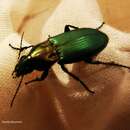Biology
provided by Arkive
This beetle is thought to have a two-year lifecycle; it breeds in spring and summer, and individuals overwinter twice, first as larvae and then as adults (3). Although the diet of this species is a mystery, it is thought that both adults and larvae are predatory, like many species of ground beetle (3). Adults have full wings, but their powers of dispersal are not known (3); they are found under stones and amongst plants, and have been recorded in April, May and July (5).
Conservation
provided by Arkive
Kugelann's ground beetle is included in the UK Biodiversity Action Plan (UK BAP) as a priority species (3); a Species Action Plan has therefore been published in order to guide its conservation (3). This plan aims to maintain all known populations, and establish at least five new populations within the former range before the year 2010 (3).
Description
provided by Arkive
This ground beetle has a stout body, with long legs, and typically has a coppery coloured fore-body and green wing cases (elytra). In some rare cases it is totally black (2).
Habitat
provided by Arkive
Inhabits heathlands where there is sandy or gravelly soil and wet patches (3), as well as sand pits (5).
Range
provided by Arkive
Formerly widespread in England from Nottinghamshire to south Wales and the south coast of England (3). The range subsequently declined, however; since 1970, the species has been recorded from just five sites in the New Forest, 3 sites in Devon and two in Dorset (4). In Europe, the species occurs in the south and west, from Spain to Hungary (3).
Status
provided by Arkive
Classified as Endangered in Great Britain (3).
Threats
provided by Arkive
The reasons for the decline of this beetle are thought to include unsuitable heathland management, and the widespread loss and fragmentation of this habitat in Britain (3).

